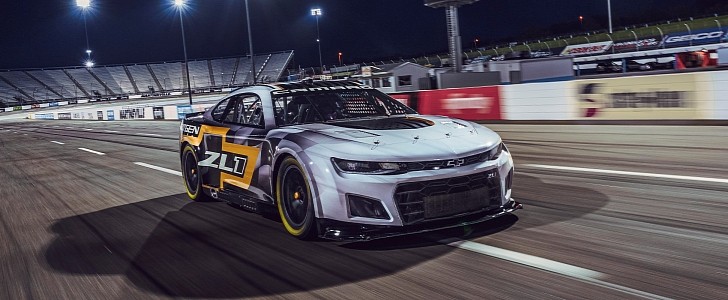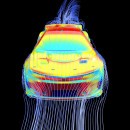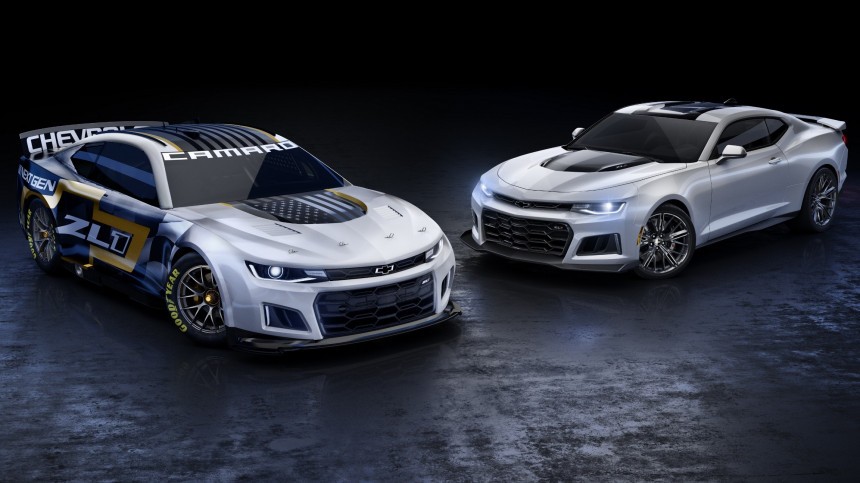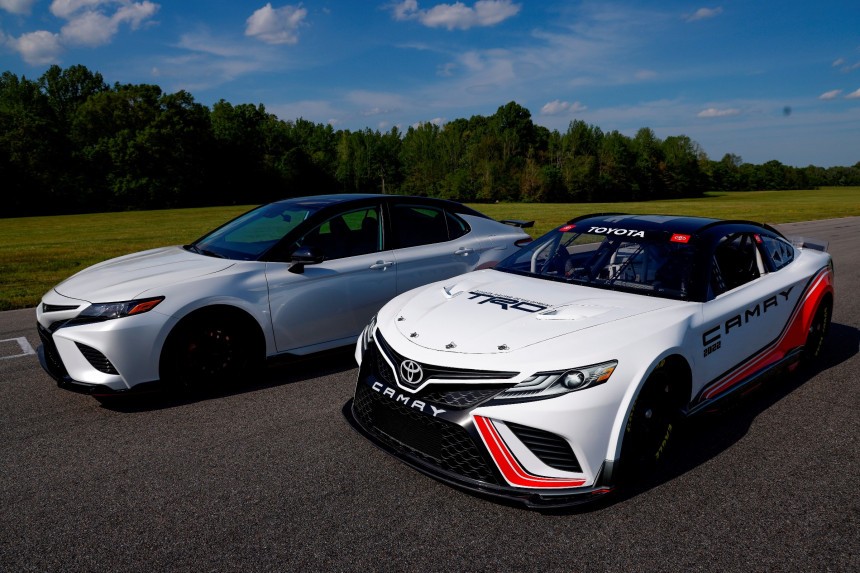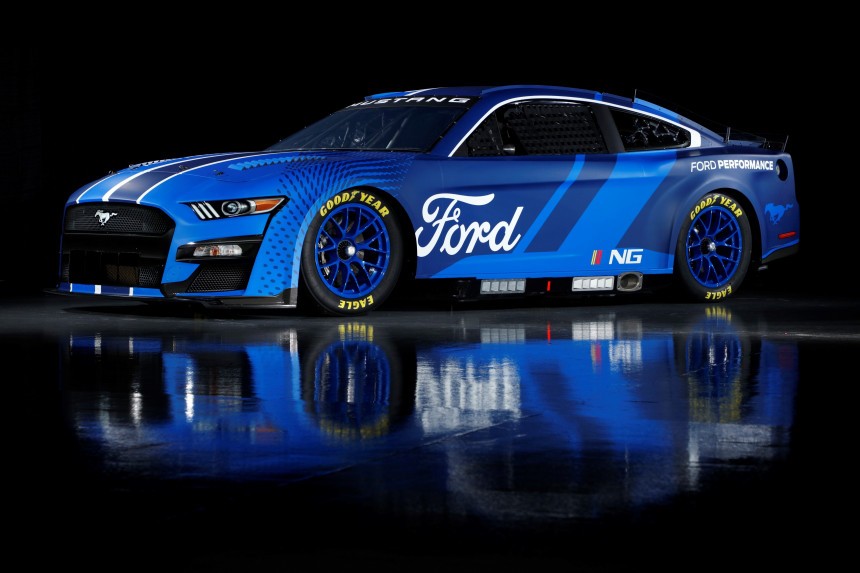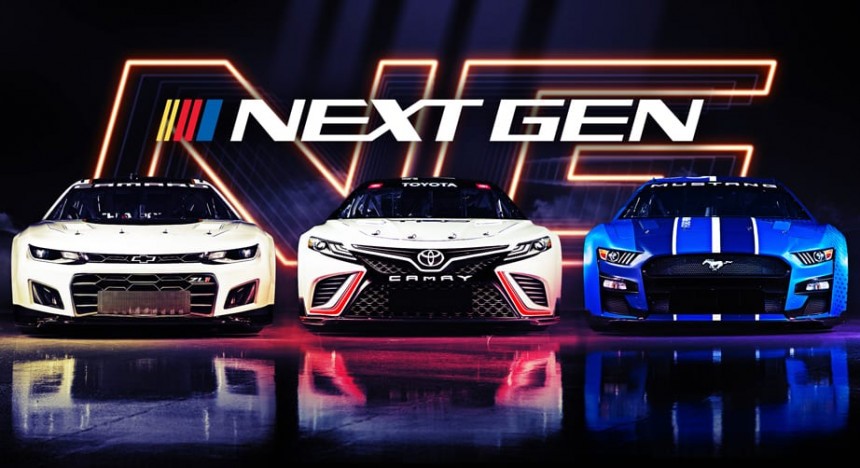NASCAR has pulled the wraps off its seventh-generation Cup car specs, dubbed the Next Gen. Set to replace the Generation 6 car, which has been in service since 2013, Next Gen will make its track debut in 2022. Designed to use all-new platforms, Next Gen brings many improvements and new technologies to the sport. We take an in-depth look at what's new and why this NASCAR Cup car is a more modern racer.
The visual changes are the most obvious. The first thing that catches the eye is that Next Gen cars were designed to closely resemble the production models they're named after. Sure, the Toyota Camry still isn't a four-door, but other than that, it's more similar to the production sedan. The same goes for the Ford Mustang and Chevrolet Camaro.
The fact that NASCAR lowered the roof and shortened the decklid helps too. The Next Gen car sits about 1.5 inches (38 mm) lower than before, while its overall length has decreased by a full six inches (152 mm). The wheelbase remains the same at 110 inches (2,794 mm), but Next Gen cars are 1.6 inches (40.6 mm) wider than before.
Safer, more affordable CFRP bodies
NASCAR finally ditched the old-school sheetmetal bodies, opting for the modern carbon-fiber-reinforced plastic route. Not only lighter, these bodies are also more flexible, which translates into enhanced safety during encounters with fellow racers and the wall. CFRP is also a more durable material. And because the bodies are now made from more panels, cars will be cheaper to repair by replacing one panel at a time rather than an entire body.
A radical approach to aerodynamics
"Radical" may sound a bit too fancy for NASCAR racing, but it's true, the Next Car is a significant departure from Gen-6 in this regard. That's because the car now features carbon fiber undertrays that create a flat surface to smooth the air that flows through the rear diffuser.
A first for NASCAR, this also reduces costs by eliminating the need to engineer exposed elements on the underside to make them more aerodynamic. Teams spent a lot of money to do that up until now and outfits that didn't have the funds to do it had to cope with inferior aerodynamics. So on top of keeping costs down, the carbon fiber undertrays will also even things out for the entire pack.
Independent rear suspension
It's hard to believe that NASCAR vehicles still use live rear axles in 2021, but that will change starting next season. The series finally made the switch to an independent, multi-link layout. The configuration allows more adjustment than before and will come in handy on road courses, which NASCAR keeps adding to the schedule.
This change also eliminates in-car adjustments to the track bar, but rear spring tension will still be adjusted in the pits. More importantly, the new suspension layout comes with four-way adjustable dampers at all corners. Provided by Ohlins, these dampers will allow engineers to tune one single unit for various tracks instead of hauling a massive amount of single-adjustment dampers for each race.
Rack-and-pinion steering
Rack-and-pinion steering has been the norm for production cars for decades, but this feature is only making its debut in NASCAR in the Next Gen car. Yes, the series has been using the ancient recirculating-ball steering box since the early days of stock car racing. It's that type of thing that calls for an "ok, boomer," but it's all in the past now. Starting next year, NASCAR drivers will finally take turns by modern standards.
Bigger, center-lock aluminum wheels
If you enjoy NASCAR tire changes, be prepared for them to be less exciting. That's because the Next Gen car switches to a center-lock wheel design. The reason for that is because the new forged aluminum wheels take too much damage from the 10,000-rpm guns used to remove lug nuts.
On top of that, NASCAR vehicles will now run on larger, 18-inch wheels instead of the old 15-inch rims. Supplied by BBS, the rollers will be wrapped in new Goodyear Eagle tires that are wider and feature a shorter sidewall.
Bigger wheels also mean that the cars can use bigger brakes. The 12.7-inch all-around rotors will be replaced by 14-inch units in the front and 15-inch pads in the rear, which will translate into enhanced stopping power. These will be paired with six-piston calipers in the front and four-piston calipers to the rear.
Five-speed transaxle
If all the changes above had you worried that NASCAR may have ditched the pushrod V8 engine, it's a good time to relax because it didn't. Chevy, Ford, and Toyota will still use pushrod designs and the V8s will still be capped at 358 cubic inches (5.9 liters) and limited to 550 horsepower for restrictor plate races and 670 horses for other tracks.
However, the new undertray design forced NASCAR to change how the exhaust is routed. Each bank of cylinders will now exit on different sides of the car, so they might sound different from the stands.
But the biggest change here is the new five-speed, X-Trac transaxle that replaces the old four-speed gearbox. Final drive ratios were selected so that there won't be downshifting at high-speed ovals, but the new transmission should make for busier gear swaps at road courses.
While all these upgrades are basically in line with what other racing series have been doing for years, they're a massive step forward for NASCAR. This series has evolved incredibly slow since it took off in 1948; remember that fuel injection wasn't adopted until 2012. Of course, it remains to be seen if racing will become better and more spectacular now, but it will bring numerous benefits into other departments.
The fact that NASCAR lowered the roof and shortened the decklid helps too. The Next Gen car sits about 1.5 inches (38 mm) lower than before, while its overall length has decreased by a full six inches (152 mm). The wheelbase remains the same at 110 inches (2,794 mm), but Next Gen cars are 1.6 inches (40.6 mm) wider than before.
Safer, more affordable CFRP bodies
NASCAR finally ditched the old-school sheetmetal bodies, opting for the modern carbon-fiber-reinforced plastic route. Not only lighter, these bodies are also more flexible, which translates into enhanced safety during encounters with fellow racers and the wall. CFRP is also a more durable material. And because the bodies are now made from more panels, cars will be cheaper to repair by replacing one panel at a time rather than an entire body.
"Radical" may sound a bit too fancy for NASCAR racing, but it's true, the Next Car is a significant departure from Gen-6 in this regard. That's because the car now features carbon fiber undertrays that create a flat surface to smooth the air that flows through the rear diffuser.
A first for NASCAR, this also reduces costs by eliminating the need to engineer exposed elements on the underside to make them more aerodynamic. Teams spent a lot of money to do that up until now and outfits that didn't have the funds to do it had to cope with inferior aerodynamics. So on top of keeping costs down, the carbon fiber undertrays will also even things out for the entire pack.
Independent rear suspension
It's hard to believe that NASCAR vehicles still use live rear axles in 2021, but that will change starting next season. The series finally made the switch to an independent, multi-link layout. The configuration allows more adjustment than before and will come in handy on road courses, which NASCAR keeps adding to the schedule.
Rack-and-pinion steering
Rack-and-pinion steering has been the norm for production cars for decades, but this feature is only making its debut in NASCAR in the Next Gen car. Yes, the series has been using the ancient recirculating-ball steering box since the early days of stock car racing. It's that type of thing that calls for an "ok, boomer," but it's all in the past now. Starting next year, NASCAR drivers will finally take turns by modern standards.
Bigger, center-lock aluminum wheels
If you enjoy NASCAR tire changes, be prepared for them to be less exciting. That's because the Next Gen car switches to a center-lock wheel design. The reason for that is because the new forged aluminum wheels take too much damage from the 10,000-rpm guns used to remove lug nuts.
Bigger wheels also mean that the cars can use bigger brakes. The 12.7-inch all-around rotors will be replaced by 14-inch units in the front and 15-inch pads in the rear, which will translate into enhanced stopping power. These will be paired with six-piston calipers in the front and four-piston calipers to the rear.
Five-speed transaxle
If all the changes above had you worried that NASCAR may have ditched the pushrod V8 engine, it's a good time to relax because it didn't. Chevy, Ford, and Toyota will still use pushrod designs and the V8s will still be capped at 358 cubic inches (5.9 liters) and limited to 550 horsepower for restrictor plate races and 670 horses for other tracks.
But the biggest change here is the new five-speed, X-Trac transaxle that replaces the old four-speed gearbox. Final drive ratios were selected so that there won't be downshifting at high-speed ovals, but the new transmission should make for busier gear swaps at road courses.
While all these upgrades are basically in line with what other racing series have been doing for years, they're a massive step forward for NASCAR. This series has evolved incredibly slow since it took off in 1948; remember that fuel injection wasn't adopted until 2012. Of course, it remains to be seen if racing will become better and more spectacular now, but it will bring numerous benefits into other departments.
